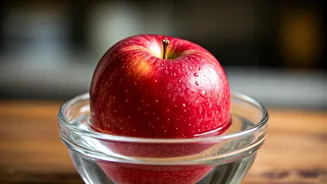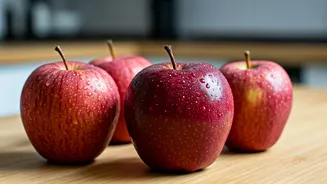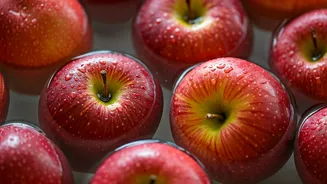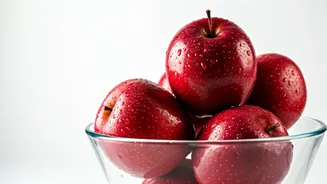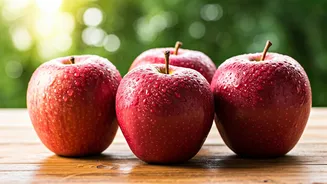The Wax Dilemma
Apples are often coated with wax, either naturally produced by the fruit or applied artificially. This wax serves to protect the apples, preventing moisture
loss and maintaining their freshness during storage and transportation. However, some people prefer to remove this wax before consumption. Artificial waxes may contain additives, prompting individuals to seek natural cleaning methods. Removing the wax also allows for a cleaner eating experience, removing any potential chemical residue or simply the feeling of a waxy coating. Understanding the type of wax and the reasons for removing it is the first step toward choosing the right cleaning approach. While the wax is generally safe, washing can improve the apple's taste and make it more appealing. Knowing how to deal with this coating empowers informed consumer choices.
Warm Water Wash
The simplest method to remove wax involves warm water. Fill a bowl with warm water, not scalding hot, and submerge the apples. The warmth helps to soften the wax. Gently rub the surface of the apple with your hands or a soft cloth under the water. The friction aids in loosening the wax. Rinse the apples thoroughly under running water, ensuring all traces of wax are removed. Dry the apples with a clean towel before consumption or storage. This method is effective for removing both natural and artificial wax. Warm water is readily available, making this a practical first step. Proper rinsing and drying are key to achieving the desired cleanliness. This is a very basic technique, but it can be surprisingly effective for light wax coatings. The warmth works by gently softening the waxes.
Vinegar Solution
Vinegar, a natural cleaning agent, can be used to remove wax effectively. Prepare a solution of equal parts water and white vinegar in a bowl or spray bottle. Place the apples in the solution for a few minutes, or spray them thoroughly. The acidity of the vinegar breaks down the wax. Using a clean cloth or brush, gently scrub the apple surfaces. Pay close attention to any areas where the wax appears more pronounced. Thoroughly rinse the apples under running water to remove the vinegar and wax residue. Dry them with a soft cloth. This method is great for more stubborn wax coatings. The vinegar helps cut through the wax more aggressively. Be careful not to let the apples soak too long, as this could slightly alter their taste. The natural cleaning power of vinegar offers a reliable option.
Baking Soda Scrub
Baking soda, a mild abrasive, is another effective cleaner. Create a paste by mixing baking soda with water until it forms a thick consistency. Apply the paste to the apple's surface, ensuring even coverage. Using a soft brush or your fingertips, gently scrub the apples, paying attention to remove all the wax. Rinse the apples under cold, running water, ensuring all baking soda residue is gone. Dry the apples thoroughly with a clean towel. This method is especially helpful for removing tough wax layers and any dirt. Baking soda offers a gentle abrasive action. It is easily accessible and safe to use. Always ensure you rinse the apples completely to remove the baking soda.
Lemon Juice Treatment
Lemon juice can be used due to its natural acidity and cleansing properties. Squeeze fresh lemon juice into a bowl. Dip a clean cloth into the lemon juice and gently rub it over the surface of the apples. The citric acid helps to dissolve the wax and adds a fresh scent. For a more intensive treatment, you can also create a lemon juice and water solution. Rinse the apples thoroughly with water after applying the lemon juice. Ensure all traces of the juice are washed away, then dry the apples. Lemon juice not only cleans but also leaves a pleasant, refreshing fragrance. This is another option for those who prefer natural, non-toxic cleaning agents. Lemon juice is also a common household item, making this method easily accessible.
Dish Soap Method
A gentle dish soap can be used to remove wax, ensuring the apples are thoroughly cleaned. Fill a bowl with warm water and add a few drops of mild dish soap. Submerge the apples in the soapy water and gently rub their surfaces with your hands or a soft brush. The soap helps to break down the wax and any other surface contaminants. Rinse the apples thoroughly under running water to remove all traces of the soap. Dry them well with a clean towel. The key is to use a mild dish soap to avoid leaving any harsh residues. Dish soap is designed to cut through oils and waxes, making it a powerful cleaning agent. It is important to rinse the apples thoroughly, ensuring no soap remains, to maintain a fresh taste.
